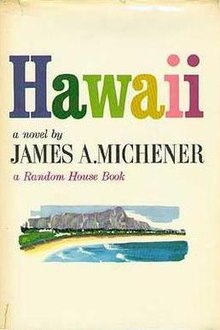Hawaii (novel)
This article needs additional citations for verification. (February 2013) |
 First edition | |
| Author | James A. Michener[1] |
|---|---|
| Language | English |
| Publisher | Random House |
Publication date | 1959 |
| Publication place | United States |
| Media type | |
| Pages | 937pp. |
Hawaii is a novel by James Michener. [2]The novel was published in 1959, the same year Hawaii became the 50th U.S. state. The book has been translated into 32 languages.[3]
The historical correctness of the novel is high, although the narrative about the early Polynesian inhabitants is based more on folklore than anthropological and archaeological sources. Written in episodic format like many of Michener's works, the book narrates the story of the original Hawaiians who sailed to the islands from Bora Bora, the early American missionaries (in this case, Calvinist missionaries) and merchants, and the Chinese and Japanese immigrants who traveled to work and seek their fortunes in Hawaii.[4] The story begins with the formation of the islands themselves millions of years ago and ends in the mid-1950s. Each section explores the experiences of different groups of arrivals.
Plot
The novel tells the history of Hawaiian Islands from the creation of the isles to the time they became an American state, through the viewpoints of selected characters who represent their ethnic and cultural groups in the story (e.g., the Kee family represents the viewpoint of Chinese-Hawaiians). Most of the chapters cover the arrivals of different peoples to the islands.[5]
Chapter 1: From the Boundless Deep describes the creation of the Hawaiian land from volcanic activity. Goes into flavorful detail describing such things as primary succession taking root on the island, to life finally blooming.[6]
Chapter 2: From the Sunswept Lagoon begins on the island of Bora Bora, where many people, including the King Tamatoa and his brother Teroro, are upset with the neighboring isles of Havaiki, Tahiti, etc. because they are trying to force the Bora Borans to give up their old gods, Tāne and Ta'aroa, and start worshiping 'Oro, the fire god, who constantly demands human sacrifices. Tamatoa suggests to his brother and friends that they should migrate to some other place where they might find religious freedom. After finally agreeing to this plan, his brother secretly puts fire to Havaiki to take revenge for the human sacrifices they have been demanding from Bora Borans. Later they take the canoe Wait for the West Wind and sail to Hawaii. Later some voyage back to Bora Bora to bring back with them some women and children and an idol of the volcano goddess, Pele.[7]
Chapter 3: From the Farm of Bitterness follows the journey of the first Christian missionaries to Hawaii in the 1800s and their influence over Hawaiian culture and customs. Many of the missionaries become founding families in the islands, including the Hales and Whipples. Michener's character Reverend Abner Hale is a caricature of true-life missionary Hiram Bingham I.[8]
Chapter 4: From the Starving Village covers the immigration of Chinese to work on the pineapple and sugarcane plantations. The patriarch of the Kee family contracts leprosy (a.k.a. the "Chinese sickness") and is sent to the leper colony in Molokai. Chapter 4 includes fictionalized version of 1893 historical events known as Overthrow of the Kingdom of Hawaii.
Chapter 5: From The Inland Sea focuses on Japanese workers brought to the islands to replace Chinese laborers who begin to start their own businesses.[who?] Also covers the bombing of Pearl Harbor.
Chapter 6: The Golden Men summarizes the changes in Hawaiian culture and economics based on the intermarriages of various groups in the islands. [9]
Cinematic adaptations
In 1966, parts of the book were made into the film Hawaii (1966), starring Max von Sydow and Julie Andrews.[10] The film focused on the book's third chapter, "From the Farm of Bitterness", which covered the settlement of the island kingdom by its first American missionaries. [11]
A sequel, The Hawaiians (1970), starring Charlton Heston, covered subsequent chapters of the book, including the arrival of the Chinese and Japanese and the growth of the plantations.[12]
References
- ^ Ali Rothstein (Fall 2001). "Michener, James Albert". Pennsylvania Center for the Book. Retrieved April 1, 2017.
- ^ Albin Krebs (October 17, 1997). "James Michener, Author of Novels That Sweep Through the History of Places". The New York Times. Retrieved March 1, 2017.
- ^ Lum, Doris (date unknown). "Michener, James A.: Hawaii" in "20th-Century American Bestsellers". University of Illinois. Retrieved on 2010-03-24 from http://www3.isrl.illinois.edu/~unsworth/courses/bestsellers/search.cgi?title=Hawaii.
- ^ "Hawaii (review)". Archived from the original on 2012-04-04. Retrieved 2011-10-10.
{{cite web}}: Unknown parameter|deadurl=ignored (|url-status=suggested) (help) - ^ ""Hawaii" by James A. Michener". Novelguide.com. Retrieved March 1, 2017.
- ^ "Hawaii A Novel by James A. Michener". Kirkus Reviews. Retrieved April 1, 2017.
- ^ "The main gods in Polynesian mythology". Introduction to Polynesian Mythology. Retrieved April 1, 2017.
- ^ David Stowe (1999). "Bingham, Hiram". In Gerald H. Anderson (ed.). Biographical Dictionary of Christian Missions. William B. Eerdmans Publishing. pp. 63–64. ISBN 978-0-8028-4680-8.
- ^ Betty Lytle (December 18, 2016). "Spotlight: 'Hawaii' by James Michener". The Oklahoman. Retrieved April 1, 2017.
- ^ Hawaii at IMDb
- ^ "Hawaii". Turner Classic Movies, Inc. Retrieved April 1, 2017.
- ^ Emily Soares. "The Hawaiians". Turner Classic Movies, Inc. Retrieved April 1, 2017.
